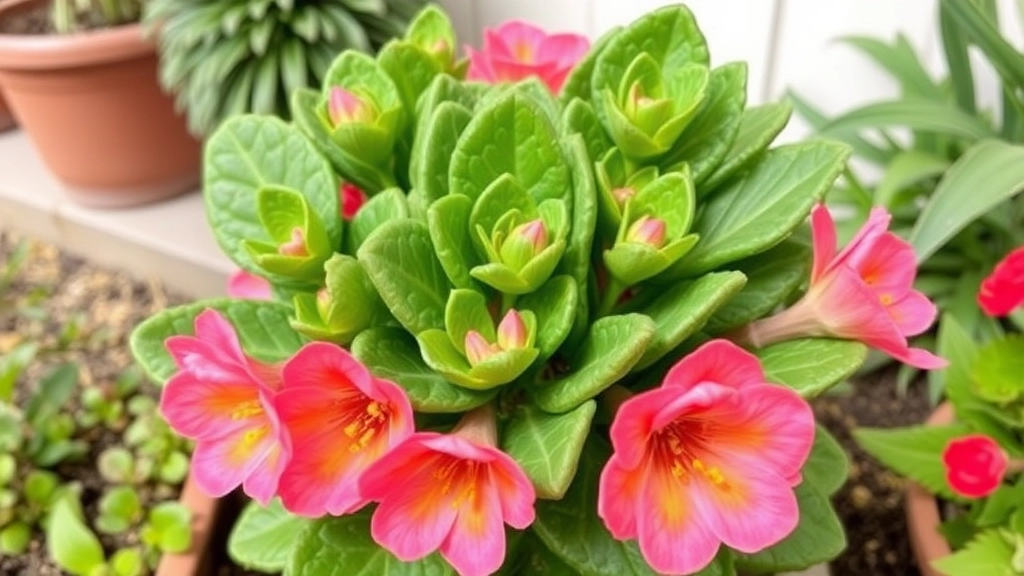Taking Care of Kalanchoe Outside
Taking care of Kalanchoe outside can be a rewarding experience if you know the right steps. First, it’s crucial to choose the right location. Kalanchoe thrives in spots with plenty of sunlight but also needs some shade during the hottest part of the day. This balance ensures the plant gets enough light without getting scorched.
Watering and Soil
When it comes to watering, Kalanchoe prefers well-draining soil. Overwatering can lead to root rot, so it’s best to let the soil dry out between waterings.
Temperature Requirements
Additionally, being mindful of temperature requirements is essential; Kalanchoe does well in warm climates but may need protection during colder months. By following these simple guidelines, you can enjoy a healthy and vibrant Kalanchoe plant in your outdoor space.
When considering where to place your Kalanchoe outdoors, you might wonder: Will it thrive in my garden? Is there enough sunlight?
Choosing the right location is crucial for the health and vibrancy of your Kalanchoe plants.
– **Sunlight Exposure:** Kalanchoe loves bright, indirect sunlight. Aim for a spot that receives at least 6 hours of light daily. Too much direct sun can scorch the leaves, while too little can hinder blooming. For more detailed care tips, check out our [ultimate guide to growing and caring for succulent plant Kalanchoe](https://planthq.org/ultimate-guide-to-growing-and-caring-for-succulent-plant-kalanchoe/).
– **Shelter from Wind:** These plants can be sensitive to strong winds. Look for a location that offers some protection, perhaps near a wall or fence.
– **Drainage:** Ensure the area has good drainage to prevent waterlogging. Kalanchoe prefers well-draining soil and does not like âwet feet.â Learn more about how to [plant Kalanchoe in a pot](https://planthq.org/how-to-plant-kalanchoe-in-a-pot-stepbystep-guide/) to ensure proper drainage and soil conditions.
– **Temperature Considerations:** Kalanchoe thrives in warmer temperatures. A location that remains warm but not excessively hot is ideal.
– **Accessibility for Care:** Choose a spot that’s easy to access for watering and maintenance. This will encourage you to care for your plants more regularly.
Understanding Optimal Sunlight Conditions
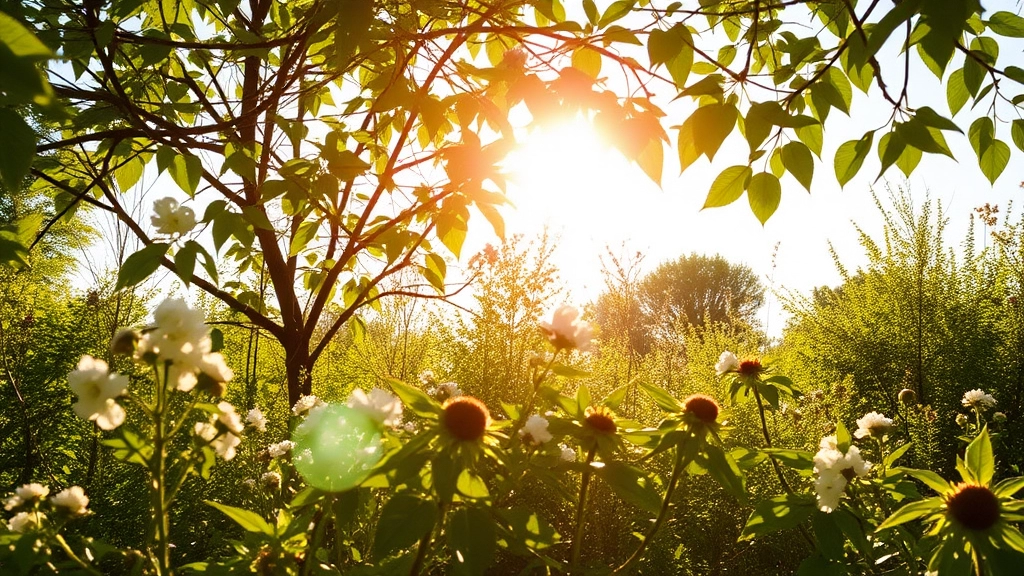
Are your Kalanchoe plants struggling to thrive outdoors?
One of the biggest secrets to keeping them happy is getting their sunlight just right.
Kalanchoe loves the sun, but there’s a fine line between sunbathing and sunburn.
Sunlight Needs
- Full Sun: Ideally, Kalanchoe needs about 6 hours of direct sunlight a day.
- Partial Shade: If you’re in a scorching area, some afternoon shade can help prevent leaf scorch.
Signs of Poor Sunlight
Keep an eye on your plants.
- Stretching: If your Kalanchoe is reaching for the light, it’s telling you it needs more sun.
- Pale Leaves: Leaves losing their vibrant color might be a sign they’re not getting enough light.
Finding the Right Spot
When choosing a location, consider:
- South or West-facing Areas: These spots typically receive the most sunlight.
- Avoiding Overhead Shade: Trees or buildings that block sunlight can hinder growth.
Seasonal Changes
As seasons shift, so does sunlight intensity.
- Monitor Changes: Be ready to move your plants if they’re not getting enough light during different times of the year.
Temperature Requirements for Outdoor Growth
When considering the outdoor growth of Kalanchoe, temperature plays a critical role.
Many gardeners often wonder, “What temperature is ideal for my Kalanchoe?”
Kalanchoe thrives best in warm climates, typically preferring temperatures between 15°C to 25°C (59°F to 77°F).
Here are some key temperature considerations for your outdoor Kalanchoe:
- Frost Sensitivity: Kalanchoe is not frost-tolerant.
- If temperatures drop below 5°C (41°F), it can suffer damage. For more detailed care tips, check out the Kalanchoe Blossfeldiana Care Guide.
- Heat Tolerance: While Kalanchoe enjoys warmth, extreme heat above 30°C (86°F) can stress the plant.
- Ensure it has some shade during the hottest parts of the day. Learn more about Kalanchoe Tomentosa Watering Best Practices.
- Temperature Fluctuations: Sudden changes can shock the plant.
- Try to keep temperature variations minimal, especially during the transition from day to night.
To protect your Kalanchoe from temperature extremes, consider planting it in a location that offers some shelter from harsh winds and direct sun during peak hours.
Best Soil Types for Kalanchoe Outdoors

When it comes to growing Kalanchoe outdoors, selecting the right soil is crucial for their health and vitality. You might be wondering, what type of soil will give my Kalanchoe the best chance to thrive?
Key Soil Characteristics
Kalanchoe plants prefer well-draining soil that prevents water accumulation around their roots. Here are some essential features to consider:
- Drainage: Look for soil that allows excess water to escape easily. This helps to prevent root rot, a common issue for Kalanchoe.
- Texture: A sandy or gritty texture is ideal. This type of soil promotes airflow and drainage.
- pH Level: Kalanchoe thrives in slightly acidic to neutral soil, ideally with a pH between 6.0 and 7.0.
Recommended Soil Types
- Cactus Mix: A pre-packaged cactus or succulent mix is often the best choice. These mixes are specifically designed for plants that require excellent drainage.
- DIY Soil Mix: If you prefer to create your own, consider combining:
- 2 parts potting soil
- 1 part perlite or coarse sand
- 1 part orchid bark or pumice
- Soil Amendments: If your garden soil is heavy and retains too much moisture, amend it with:
- Perlite
- Coarse sand
- Gravel
Tips for Soil Preparation
- Testing Soil: Before planting, test your garden soil to understand its drainage capabilities and pH level.
- Amending Soil: If necessary, amend your garden soil to improve its drainage by mixing in the recommended materials.
- Mulching: A layer of gravel or small stones on top of the soil can help with drainage and prevent soil erosion.
When it comes to nurturing your outdoor Kalanchoe, watering is a crucial aspect that can make or break your plant’s health.
**Understanding Water Needs**
Kalanchoe, being a succulent, has unique watering requirements. Overwatering is a common mistake that many gardeners make. Here’s how to ensure your Kalanchoe thrives:
– **Frequency**: Water your Kalanchoe every two to three weeks during the growing season (spring and summer). In winter, reduce this to once a month.
– **Soil Check**: Always check the soil moisture before watering. Insert your finger about an inch into the soil. If it feels dry, it’s time to water.
– **Watering Technique**: Water deeply but infrequently. Ensure that water reaches the roots without pooling around the base of the plant.
**Signs of Overwatering**
Be vigilant for signs that you may be overwatering:
– Yellowing leaves
– Mushy stems
– Foul odour from the soil
If you notice these signs, cut back on watering and allow the soil to dry out completely before the next watering session.
**Best Practices for Watering**
To ensure your Kalanchoe receives the right amount of moisture:
– **Use Well-Draining Soil**: This helps prevent water retention.
– **Water Early**: Water in the morning to allow for evaporation and to prevent fungal diseases.
– **Consider Rainfall**: If your area experiences heavy rain, adjust your watering schedule accordingly.
For more detailed information on how to properly care for your Kalanchoe, you can refer to the [ultimate guide on Kalanchoe succulents](https://planthq.org/how-to-care-for-kalanchoe-succulent-ultimate-guide/). Additionally, if you need tips on growing and caring for specific varieties like the Mother of Thousands, check out this [comprehensive care guide](https://planthq.org/complete-guide-to-growing-kalanchoe-mother-of-thousands/).
Protecting Kalanchoe from Weather Extremes
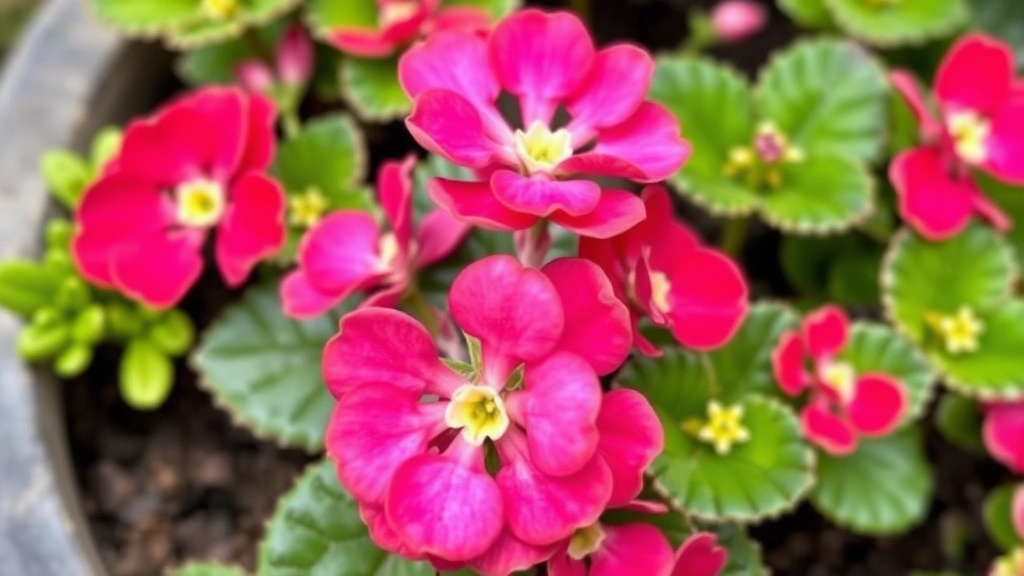
So, you’ve got your Kalanchoe thriving outdoors, but what happens when Mother Nature throws a curveball?
Weather extremes can really put your plants to the test.
Here’s how to keep your Kalanchoe safe and sound:
1. Sunburn Protection
- Shade Cloth: Use a shade cloth during scorching summer days.
- Move Them: If possible, relocate pots to a shadier spot.
2. Frost and Cold Weather
- Cover Up: When frost is forecasted, cover your Kalanchoe with blankets or burlap.
- Bring Indoors: If it’s going to be particularly cold, consider bringing your Kalanchoe inside for the night.
3. Heavy Rain and Wind
- Shelter: Position your Kalanchoe near a wall or under a patio to shield them from heavy rain.
- Drainage: Ensure pots have good drainage to prevent waterlogging.
4. Humidity Levels
- Ventilation: If you live in a humid area, ensure good airflow around your plants to prevent rot.
- Spacing: Don’t overcrowd your Kalanchoe; give them room to breathe.
5. Heat Waves
- Water Wisely: Increase watering during heat waves, but avoid letting them sit in water.
- Mulch: Add a layer of mulch to help retain moisture in the soil.
Managing Common Outdoor Pests and Diseases
As we delve into the care of outdoor Kalanchoe, it’s crucial to address the potential challenges posed by pests and diseases.
Common Pests to Watch For
Outdoor Kalanchoe can attract various pests that may jeopardise their health. Here are some common culprits:
- Aphids: Tiny green or black insects that suck sap from the plant.
- Mealybugs: White, cotton-like pests that cluster in leaf joints.
- Spider Mites: Small, spider-like creatures that create fine webbing and cause leaf discoloration.
- Scale Insects: Hard, shell-like pests that attach themselves to stems and leaves.
Prevention and Control Strategies
To keep your Kalanchoe thriving, consider these effective strategies:
- Regular Inspections: Check your plants weekly for any signs of infestation.
- Natural Predators: Introduce ladybugs or lacewings, which feed on pests like aphids.
- Neem Oil: A natural pesticide that can be sprayed to deter pests without harming your plant.
- Insecticidal Soap: Effective against soft-bodied insects, it can be applied directly to affected areas.
Common Diseases to Monitor
Kalanchoe can also fall victim to certain diseases, which can hinder their growth and flowering. Notable diseases include:
- Powdery Mildew: A fungal disease that appears as a white powdery substance on leaves.
- Root Rot: Often caused by overwatering, leading to mushy roots and plant decline.
Disease Management Tips
To safeguard your Kalanchoe from diseases, implement these practices:
Fertilization Tips for Outdoor Kalanchoe
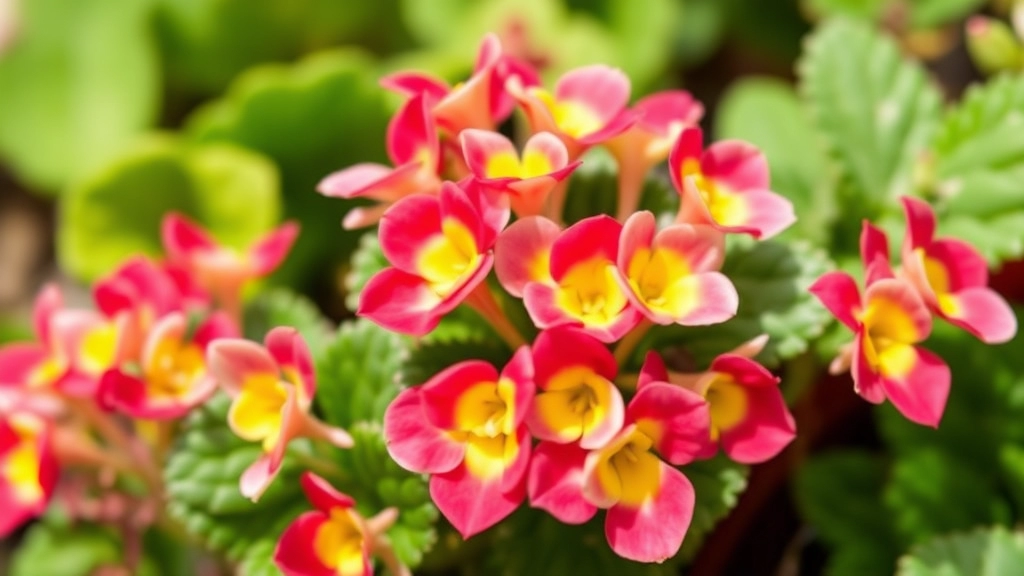
So, you’ve got your Kalanchoe thriving outdoors, and now you’re wondering how to give it that extra boost, right? Fertilizing is key to keeping your plants healthy and vibrant.
When to Fertilize:
- Growing Season: Focus on spring and summer when your Kalanchoe is actively growing.
- Frequency: Every 4-6 weeks during the growing season is ideal.
Types of Fertilizer:
- Balanced Fertilizer: Look for something like a 10-10-10 or 20-20-20 formula.
- Liquid Fertilizer: Easy to apply and great for quick absorption.
- Slow-Release Pellets: These are fantastic for a long-lasting effect.
Application Tips:
- Dilute: Always dilute liquid fertilizers to half strength to avoid burning the roots.
- Water First: Give your plant a good drink before applying fertilizer. This helps prevent shock.
- Even Distribution: Spread evenly around the base of the plant, avoiding direct contact with the stems.
Signs Your Kalanchoe Needs Fertilizer:
- Pale Leaves: This could indicate nutrient deficiency.
- Stunted Growth: If your plant isn’t growing much, it might be time to feed it.
Extra Boosts:
- Organic Options: Consider using compost or worm castings for a natural approach.
- Foliar Feeding: Spraying a diluted liquid fertilizer on the leaves can also be beneficial.
How to Prune and Deadhead Kalanchoe Outdoors
When it comes to keeping your outdoor Kalanchoe thriving, pruning and deadheading are essential tasks that can significantly enhance its health and appearance. You might be wondering, “How do I even start with this?”
Why Prune and Deadhead?
- Encourages New Growth: By removing old or dead flowers, you stimulate the plant to produce new blooms.
- Maintains Shape: Regular pruning helps keep your Kalanchoe looking tidy and well-shaped.
- Prevents Disease: Removing spent flowers and unhealthy leaves can reduce the risk of disease.
When to Prune and Deadhead
- After Blooming: The best time to deadhead is right after the flowering period. This allows the plant to focus its energy on new growth.
- Regular Maintenance: Prune any leggy or unhealthy growth throughout the growing season.
How to Prune and Deadhead Kalanchoe
- Gather Your Tools: Use clean, sharp scissors or pruning shears to avoid damaging the plant.
- Identify Spent Blooms: Look for flowers that have wilted or turned brown.
- Cut at the Base: Remove spent flowers by cutting the stem just above a set of healthy leaves. This encourages new growth.
- Trim Unhealthy Leaves: Remove any yellow or damaged leaves to promote overall health.
- Shape the Plant: If necessary, trim back any overly long stems to maintain a compact shape.
Tips for Effective Pruning
- Avoid Over-pruning: Only remove what is necessary to keep the plant healthy.
- Be Gentle: Handle the plant carefully to avoid stress.
- Sanitize Tools: Always clean your tools before and after use to prevent the spread of disease.
For more detailed care tips, check out our guide on growing and caring for flowering Kalanchoe Blossfeldiana. Additionally, if you’re interested in propagation, our step-by-step guide on propagating Kalanchoe leaves offers valuable insights.
Re-blooming Kalanchoe Outdoors: Best Practices
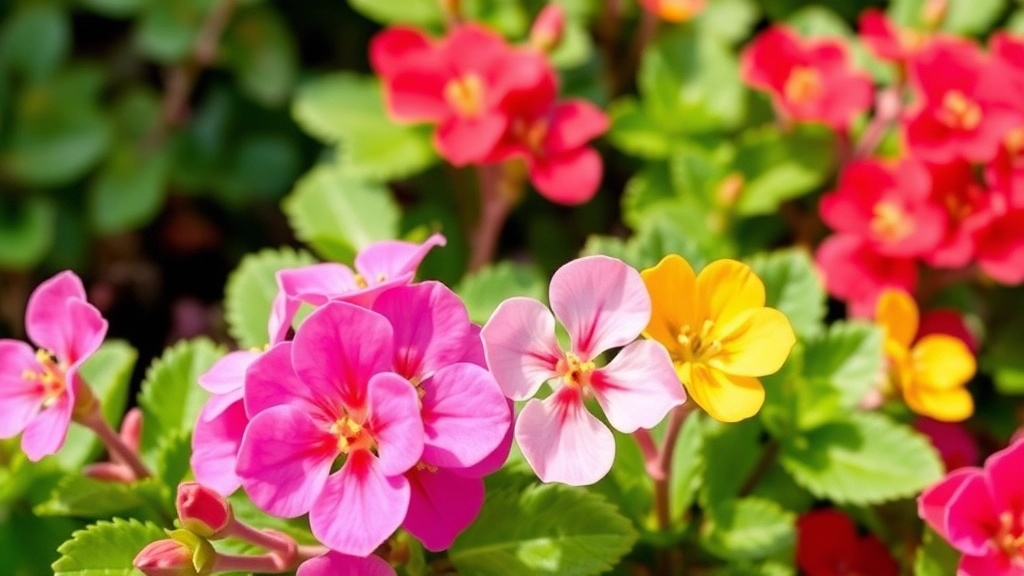
So, you’ve enjoyed the vibrant blooms of your Kalanchoe, but now you’re wondering how to coax those lovely flowers back for another show.
Don’t worry, it’s totally doable!
Here’s how to get your Kalanchoe to re-bloom outdoors:
- Light It Up
Ensure your Kalanchoe is getting plenty of bright, indirect sunlight.
Aim for at least 6 hours a day. This helps stimulate those flower buds. - Cut Back on Watering
After the blooming period, reduce watering.
Let the soil dry out between waterings. This stress encourages new blooms. - Fertilize Wisely
Use a balanced fertiliser every 4-6 weeks during the growing season.
Look for a formula rich in phosphorus to promote blooming. - Prune for New Growth
Trim away spent flowers and any leggy growth.
This encourages the plant to focus its energy on new blooms. - Temperature Check
Kalanchoe loves warmth. Keep it in a spot where temperatures stay between 15-25°C.
Avoid chilly drafts that could hinder blooming. - Patience is Key
Sometimes, it just takes time.
Keep caring for your plant, and soon enough, you’ll see those gorgeous flowers again.
Seasonal Care: Bringing Kalanchoe Indoors for Winter
As the colder months approach, many Kalanchoe enthusiasts find themselves wondering how to transition their beloved plants indoors.
Why Bring Kalanchoe Indoors?
Kalanchoe is a succulent that thrives in warm, sunny conditions. As temperatures drop, it’s crucial to protect these plants from frost and harsh weather. Here’s what you need to consider:
Timing is Key
- Monitor the Weather: Keep an eye on local forecasts. Ideally, bring your Kalanchoe indoors before temperatures consistently dip below 10°C (50°F).
- Observe Plant Health: If your Kalanchoe shows signs of stress, such as wilting or leaf drop, it may be time to move it inside sooner.
Preparing for the Move
- Inspect for Pests: Check your Kalanchoe for any pests or diseases before bringing it indoors. Treat any issues to prevent them from spreading in your home.
- Clean the Leaves: Wipe the leaves gently with a damp cloth to remove dust and any potential pests.
Ideal Indoor Conditions
- Light Requirements: Place your Kalanchoe near a south-facing window where it can receive ample sunlight. If natural light is limited, consider using grow lights.
- Temperature Control: Keep indoor temperatures between 15°C to 20°C (59°F to 68°F). Avoid placing it near heating vents or drafty windows.
Watering and Care
- Adjust Watering Routine: Indoor Kalanchoe typically requires less water than outdoor plants. Allow the soil to dry out between waterings to prevent root rot.
- Humidity Levels: Kalanchoe prefers low humidity. Ensure good air circulation around the plant.
Monitoring for Issues
- Watch for Stress Signs: Keep an eye out for yellowing leaves or drooping, which can indicate overwatering or inadequate light.
- Regular Checks: Periodically inspect for pests, especially spider mites and mealybugs, which can thrive indoors.
For more detailed care tips, you might find our Kalanchoe Mother of Thousands care guide helpful. Additionally, if you’re dealing with specific issues like drooping leaves, our article on how to fix drooping Kalanchoe leaves offers practical solutions.
Propagating Kalanchoe for Outdoor Planting
So, you’re ready to expand your Kalanchoe collection? Propagating these beauties is a fantastic way to do just that. It’s not just about saving a few quid; it’s about nurturing a new plant from something you already love.
Why Propagate Kalanchoe?
- Cost-effective: Why buy new plants when you can grow your own?
- Personal touch: Each plant carries a bit of your gardening journey.
- Sharing joy: Give cuttings to friends and family!
Methods of Propagation
Here are a couple of easy ways to propagate Kalanchoe:
- Leaf Cuttings:
- Snip a healthy leaf from your Kalanchoe.
- Let it dry for a few hours to form a callus.
- Place it in well-draining soil, keeping it slightly moist.
- In a few weeks, you’ll see roots forming!
- Offsets:
- Look for small plantlets at the base of your Kalanchoe.
- Gently separate them from the main plant.
- Replant them in soil and care for them as you would with a mature plant.
Tips for Successful Propagation
- Timing is key: Spring or early summer is the best time for propagation.
- Right soil: Use a cactus mix or a well-draining potting soil.
- Patience pays off: It might take a while for the new plants to establish, but trust the process!
Keeping it Real
I remember my first time propagating Kalanchoe. I was nervous, thinking I’d mess it up. But after following these simple steps, I had a whole new batch of plants flourishing in my garden. It felt rewarding!
For more detailed advice on propagation, check out our Florist Kalanchoe Propagation Guide. If you’re also interested in identifying different Kalanchoe varieties, our Kalanchoe Succulent Identification Guide is a must-read!
FAQs on Kalanchoe Care Outside
What are the optimal sunlight conditions for Kalanchoe outdoors?
Kalanchoe plants thrive best with about 6 hours of direct sunlight daily. In very hot climates, they may benefit from some afternoon shade to prevent leaf scorch.
How can I tell if my Kalanchoe is not getting enough sunlight?
Signs of insufficient sunlight include stretching (the plant reaching for light) and pale leaves losing their vibrant color.
What type of soil is best for outdoor Kalanchoe plants?
Kalanchoe prefers well-draining soil with a sandy or gritty texture. A cactus or succulent mix is ideal, or you can create your own mix with potting soil, perlite, and orchid bark.
How do I protect my Kalanchoe from extreme weather conditions?
Use shade cloths for sunburn protection, cover plants during frost, position them in sheltered spots during heavy rain, and ensure good ventilation in humid areas. During heat waves, increase watering and use mulch to retain soil moisture.
When and how should I fertilize my outdoor Kalanchoe?
Fertilize during the growing season (spring and summer) every 4-6 weeks. Use a balanced fertilizer like a 10-10-10 or 20-20-20 formula, dilute liquid fertilizers to half strength, and water the plant before applying fertilizer to prevent shock.
What are the signs that my Kalanchoe needs fertilization?
Indicators include pale leaves and stunted growth. These signs suggest a nutrient deficiency that can be remedied with proper fertilization.
How can I encourage my Kalanchoe to re-bloom outdoors?
Ensure the plant gets plenty of bright, indirect sunlight, reduce watering after the blooming period, use a balanced fertilizer rich in phosphorus, prune spent flowers and leggy growth, and maintain temperatures between 15-25°C.
Can I use organic options to fertilize my Kalanchoe?
Yes, organic options like compost or worm castings are excellent for providing nutrients. Foliar feeding with a diluted liquid fertilizer can also be beneficial.
References
-
Understanding Kalanchoe Sunlight Requirements – Gardening Know How
-
Growing Kalanchoe Outdoors – The Spruce
-
How to Grow Kalanchoe – Gardening Channel
